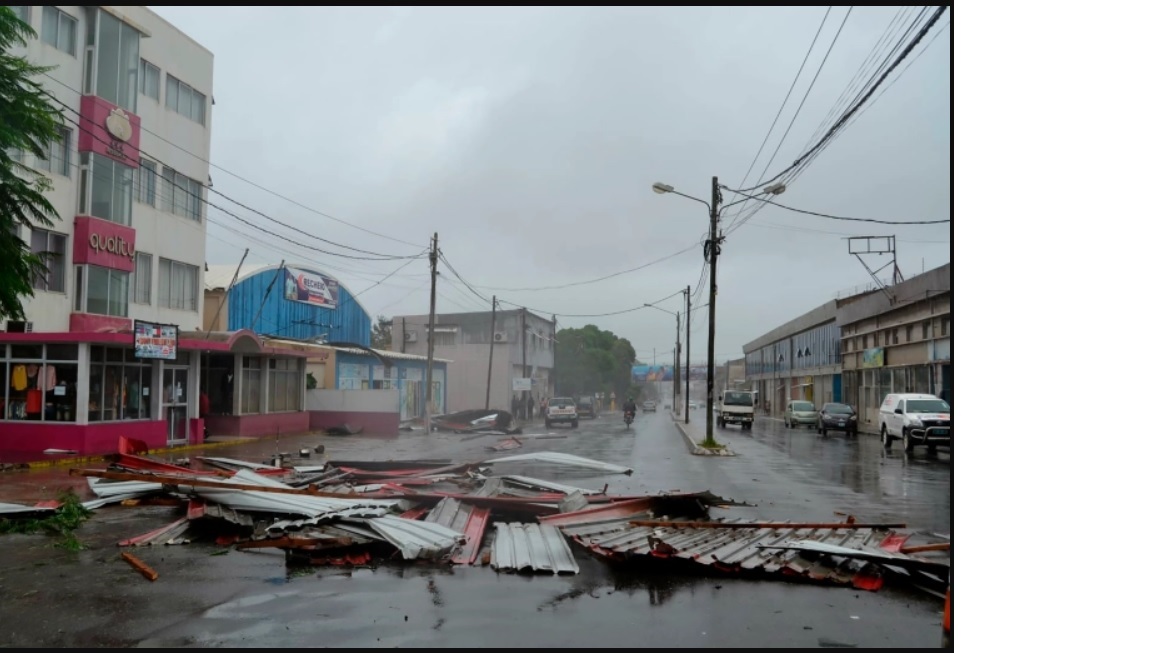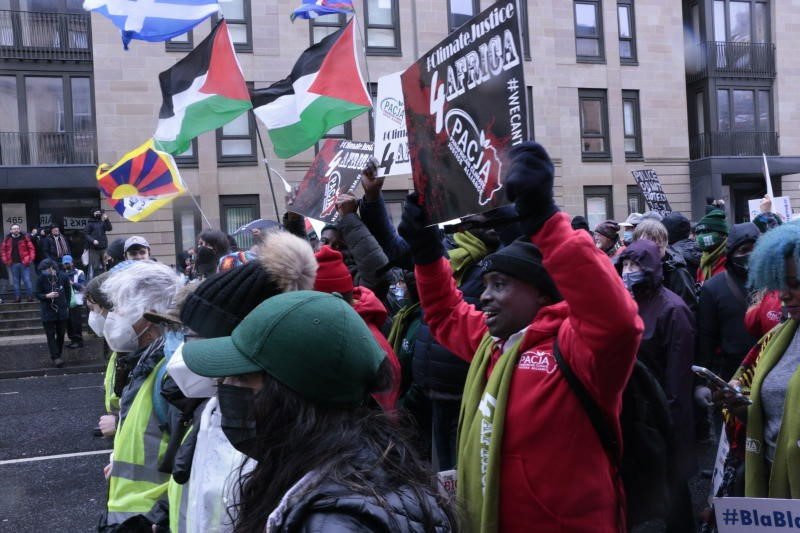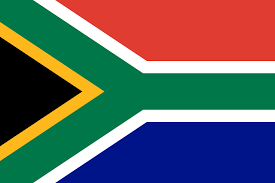Climate Change Impacting Southern Africa from Malawi to Madagascar
2022-03-24 20:25:37

The countries of Mozambique, Malawi and Madagascar contribute almost nothing to the advent of climate disasters. These states should be assisted with relief efforts and the building of infrastructure designed to minimize the impact of cyclones and other serious weather disturbances.
Two cyclones recently leave dozens dead, hundreds of thousands impacted
Fears about the impact of climate change is a reality for billions of people around the globe.
In Southern Africa, a series of cyclones and tropical storms have done enormous damage in Mozambique, Madagascar and Malawi.
The most recent Cyclone Gombe resulted in the displacement of thousands of people in Mozambique and Malawi. An earlier Tropical Storm Ana struck Madagascar along with Mozambique and Malawi.
Cyclone Gombe reached the coast of Mossuril district in Nampula Province in Mozambique on March 11. The severe tropical event was marked by winds as high as 190km/h (118 miles) with rainfall at 200/24h (7.874 inches).
Gombe came just two months after Ana which struck Mozambique in January. In addition to this there was Tropical Depression Dumako which landed in February. Just in Mozambique, 200,000 people were impacted in Nampula, Zambezia and Tete provinces. Before the month of March was over there were forecasts for heavy rains in Zambezia, Sofala, Manica and Nampula provinces which could possibly result in flooding in Licungo and Zambezia river basins along with the southeast area of Tete.

According to an article on the climate situation in southeast Africa along the Indian Ocean, Afrik 21 notes: “In neighboring Malawi, the disaster caused heavy rains leading to flooding in nine districts, including Machinga located 256 km (159 miles) from the capital Lilongwe. A total of seven people died in the south of the country, while authorities deployed rescue teams to flood-affected areas such as Liwonde, where the country’s fourth largest national park is located, and the Namandanje River, which serves as the border with Mozambique. Although Gombe did not reach Madagascar, the country most vulnerable to natural disasters in East Africa, the big island experienced other phenomena at the beginning of the year, such as cyclone Batisrai, which followed storm Ana and had wind gusts of 235 km (146 miles) per hour. After causing flooding across the country, destroying buildings and uprooting trees, the storm left 92 people dead and 50,000 displaced." (afrik21.africa)
All three of these states, Mozambique, Malawi and Madagascar, belong to the Southern African Development Community (SADC), a regional organization encompassing 16 countries across the entire sub-continent and the Democratic Republic of Congo (DRC). SADC holds regular meetings to discuss issues of mutual concern including greater cooperation and economic integration among its members-nations.
However, the regional plans debated and ratified by SADC summits and working groups are impeded due to the repeated tropical storms and other weather disasters. The region of Southern Africa is endowed with natural resources and close proximity to the Indian Ocean, making its potential for growth and development unlimited.
For example, Mozambique is the center of a major energy project designed to produce Liquified Natural Gas (LNG) for export in Cabo Delgado province. Independent of the recent cyclones, there is an armed insurgency which has attacked towns and villages throughout the province stalling LNG development while prompting people to flee seeking safety outside the area. The SADC and Rwandan military forces have been deployed in Cabo Delgado to assist the Mozambique armed forces in anti-insurgency operations.
SADC countries are perhaps the most unified politically of the regional organizations across the continent. Even the African Union (AU), which encompasses 55-member states, which maintains a secretariat in Addis Ababa, Ethiopia at its headquarters, has not been able to act as rapidly in implementing its proposals as the SADC.
Cyclone Gombe and other climate disastrous occurrences poses enormous challenges for the region along with geo-political areas. With the public health crisis over the last two years due to COVID-19, the compounding reality of cyclones and subsequent flooding, severely hampers the planning capacity for governments and other sectors of society. Consequently, cyclones are a contributing factor in the rising national debt levels of African states.
The Failed Legacy of COP26
Last year another major climate conference was sponsored by the United Nations in Glasgow, Scotland. The COP26 gathering was the scene of much political struggle surrounding the issues discussed and most importantly, the final declaration of the event.

The UN in their report on the meeting said: “The UN Climate Change Conference in Glasgow (COP26) brought together 120 world leaders and over 40,000 registered participants, including 22,274 party delegates, 14,124 observers and 3,886 media representatives. For two weeks, the world was riveted on all facets of climate change — the science, the solutions, the political will to act, and clear indications of action…. ‘The approved texts are a compromise,’ said UN Secretary-General António Guterres. ‘They reflect the interests, the conditions, the contradictions and the state of political will in the world today. They take important steps, but unfortunately the collective political will was not enough to overcome some deep contradictions.’" (www.un.org)
Yet these compromises are a direct result of the western states from Washington to Berlin which often objected to the adoption of concrete goals in regard to the emissions of greenhouse gases around the globe. It is the capitalist countries of the United States and Western Europe which are the most culpable in the degradation of the environmental status of the planet.
In fact, some studies suggest that it is the U.S. Department of Defense which is the largest polluter internationally. Through the demand for armaments, ordnances, fighter jets and other military equipment, along with the presence of more than 7,000 military bases established and administered by the Pentagon, Washington and Wall Street are behind the burning of harmful toxins which damage the air, land and water of countries around the globe.
A report published in 2016 on the link between the climate crisis and U.S. militarism says: “Yet, despite being the planet’s single greatest institutional consumer of fossil fuels, the Pentagon has been granted a unique exemption from reducing – or even reporting – its pollution. The U.S. won this prize during the 1998 Kyoto Protocol negotiations after the Pentagon insisted on a ‘national security provision’ that would place its operations beyond global scrutiny or control…. The Air Force accounts for about half of the Pentagon’s operational energy consumption, followed by the Navy (33 percent) and Army (15 percent). In 2012, oil accounted for nearly 80 percent of the Pentagon’s energy consumption, followed by electricity, natural gas and coal." (www.earthisland.org)
Imperialism and Climate Change
With these facts being placed in an article without any refutation by the Pentagon, illustrates clearly that the struggle against climate change must also encompass as an essential point of departure, the role of the Pentagon’s imperialist militarism. These issues remain with the international community in the current period due to the war initiated through attempts to expand the North Atlantic Treaty Organization (NATO) in Eastern European to the state of Ukraine combined with efforts to rearm Germany and to reverse the neutrality of Finland and Switzerland.
Anti-imperialists and solidarity activists based in the western countries should never refrain from pointing to the role of Pentagon military bases and war efforts as the major contributing factors to the worsening of climate change. East Africa has been a focal point for what is often labeled as “natural disasters" beyond the capacity of human being to prevent. Nonetheless, many scientists and analysts have repeatedly drawn a connection between mass production, light industry, mining, food production, military services and climate change.
The countries of Mozambique, Malawi and Madagascar contribute almost nothing to the advent of climate disasters. These states should be assisted with relief efforts and the building of infrastructure designed to minimize the impact of cyclones and other serious weather disturbances.
Reconstruction of damaged communities in Southern Africa should be supported by people of goodwill in the imperialist countries since it is their own governments and corporations which have for decades implemented policies which have disproportionate negative impact on the peoples of Africa, Asia and Latin America as well as oppressed peoples and the working class inside the western industrialized states in North America and Western Europe.
Fears about the impact of climate change is a reality for billions of people around the globe.
In Southern Africa, a series of cyclones and tropical storms have done enormous damage in Mozambique, Madagascar and Malawi.
The most recent Cyclone Gombe resulted in the displacement of thousands of people in Mozambique and Malawi. An earlier Tropical Storm Ana struck Madagascar along with Mozambique and Malawi.
Cyclone Gombe reached the coast of Mossuril district in Nampula Province in Mozambique on March 11. The severe tropical event was marked by winds as high as 190km/h (118 miles) with rainfall at 200/24h (7.874 inches).
Gombe came just two months after Ana which struck Mozambique in January. In addition to this there was Tropical Depression Dumako which landed in February. Just in Mozambique, 200,000 people were impacted in Nampula, Zambezia and Tete provinces. Before the month of March was over there were forecasts for heavy rains in Zambezia, Sofala, Manica and Nampula provinces which could possibly result in flooding in Licungo and Zambezia river basins along with the southeast area of Tete.

Cyclone Gombe hits Mozambique.
According to an article on the climate situation in southeast Africa along the Indian Ocean, Afrik 21 notes: “In neighboring Malawi, the disaster caused heavy rains leading to flooding in nine districts, including Machinga located 256 km (159 miles) from the capital Lilongwe. A total of seven people died in the south of the country, while authorities deployed rescue teams to flood-affected areas such as Liwonde, where the country’s fourth largest national park is located, and the Namandanje River, which serves as the border with Mozambique. Although Gombe did not reach Madagascar, the country most vulnerable to natural disasters in East Africa, the big island experienced other phenomena at the beginning of the year, such as cyclone Batisrai, which followed storm Ana and had wind gusts of 235 km (146 miles) per hour. After causing flooding across the country, destroying buildings and uprooting trees, the storm left 92 people dead and 50,000 displaced." (afrik21.africa)
All three of these states, Mozambique, Malawi and Madagascar, belong to the Southern African Development Community (SADC), a regional organization encompassing 16 countries across the entire sub-continent and the Democratic Republic of Congo (DRC). SADC holds regular meetings to discuss issues of mutual concern including greater cooperation and economic integration among its members-nations.
However, the regional plans debated and ratified by SADC summits and working groups are impeded due to the repeated tropical storms and other weather disasters. The region of Southern Africa is endowed with natural resources and close proximity to the Indian Ocean, making its potential for growth and development unlimited.
For example, Mozambique is the center of a major energy project designed to produce Liquified Natural Gas (LNG) for export in Cabo Delgado province. Independent of the recent cyclones, there is an armed insurgency which has attacked towns and villages throughout the province stalling LNG development while prompting people to flee seeking safety outside the area. The SADC and Rwandan military forces have been deployed in Cabo Delgado to assist the Mozambique armed forces in anti-insurgency operations.
SADC countries are perhaps the most unified politically of the regional organizations across the continent. Even the African Union (AU), which encompasses 55-member states, which maintains a secretariat in Addis Ababa, Ethiopia at its headquarters, has not been able to act as rapidly in implementing its proposals as the SADC.
Cyclone Gombe and other climate disastrous occurrences poses enormous challenges for the region along with geo-political areas. With the public health crisis over the last two years due to COVID-19, the compounding reality of cyclones and subsequent flooding, severely hampers the planning capacity for governments and other sectors of society. Consequently, cyclones are a contributing factor in the rising national debt levels of African states.
The Failed Legacy of COP26
Last year another major climate conference was sponsored by the United Nations in Glasgow, Scotland. The COP26 gathering was the scene of much political struggle surrounding the issues discussed and most importantly, the final declaration of the event.

COP26 mass demonstration in Glasgow.
The UN in their report on the meeting said: “The UN Climate Change Conference in Glasgow (COP26) brought together 120 world leaders and over 40,000 registered participants, including 22,274 party delegates, 14,124 observers and 3,886 media representatives. For two weeks, the world was riveted on all facets of climate change — the science, the solutions, the political will to act, and clear indications of action…. ‘The approved texts are a compromise,’ said UN Secretary-General António Guterres. ‘They reflect the interests, the conditions, the contradictions and the state of political will in the world today. They take important steps, but unfortunately the collective political will was not enough to overcome some deep contradictions.’" (www.un.org)
Yet these compromises are a direct result of the western states from Washington to Berlin which often objected to the adoption of concrete goals in regard to the emissions of greenhouse gases around the globe. It is the capitalist countries of the United States and Western Europe which are the most culpable in the degradation of the environmental status of the planet.
In fact, some studies suggest that it is the U.S. Department of Defense which is the largest polluter internationally. Through the demand for armaments, ordnances, fighter jets and other military equipment, along with the presence of more than 7,000 military bases established and administered by the Pentagon, Washington and Wall Street are behind the burning of harmful toxins which damage the air, land and water of countries around the globe.
A report published in 2016 on the link between the climate crisis and U.S. militarism says: “Yet, despite being the planet’s single greatest institutional consumer of fossil fuels, the Pentagon has been granted a unique exemption from reducing – or even reporting – its pollution. The U.S. won this prize during the 1998 Kyoto Protocol negotiations after the Pentagon insisted on a ‘national security provision’ that would place its operations beyond global scrutiny or control…. The Air Force accounts for about half of the Pentagon’s operational energy consumption, followed by the Navy (33 percent) and Army (15 percent). In 2012, oil accounted for nearly 80 percent of the Pentagon’s energy consumption, followed by electricity, natural gas and coal." (www.earthisland.org)
Imperialism and Climate Change
With these facts being placed in an article without any refutation by the Pentagon, illustrates clearly that the struggle against climate change must also encompass as an essential point of departure, the role of the Pentagon’s imperialist militarism. These issues remain with the international community in the current period due to the war initiated through attempts to expand the North Atlantic Treaty Organization (NATO) in Eastern European to the state of Ukraine combined with efforts to rearm Germany and to reverse the neutrality of Finland and Switzerland.
Anti-imperialists and solidarity activists based in the western countries should never refrain from pointing to the role of Pentagon military bases and war efforts as the major contributing factors to the worsening of climate change. East Africa has been a focal point for what is often labeled as “natural disasters" beyond the capacity of human being to prevent. Nonetheless, many scientists and analysts have repeatedly drawn a connection between mass production, light industry, mining, food production, military services and climate change.
The countries of Mozambique, Malawi and Madagascar contribute almost nothing to the advent of climate disasters. These states should be assisted with relief efforts and the building of infrastructure designed to minimize the impact of cyclones and other serious weather disturbances.
Reconstruction of damaged communities in Southern Africa should be supported by people of goodwill in the imperialist countries since it is their own governments and corporations which have for decades implemented policies which have disproportionate negative impact on the peoples of Africa, Asia and Latin America as well as oppressed peoples and the working class inside the western industrialized states in North America and Western Europe.
News
powered by Surfing Waves
Support ASCARF
ASCARF is a tax-exempt Public Benefit Organisation (PBO) that supports Public Benefit Activities (PBA). ASCARF appreciates your donations to develop the mission into global online Research Center. All accumulated funds to be forwarded to our Public Benefit Activities and outstanding authors. Thank you in advance!







